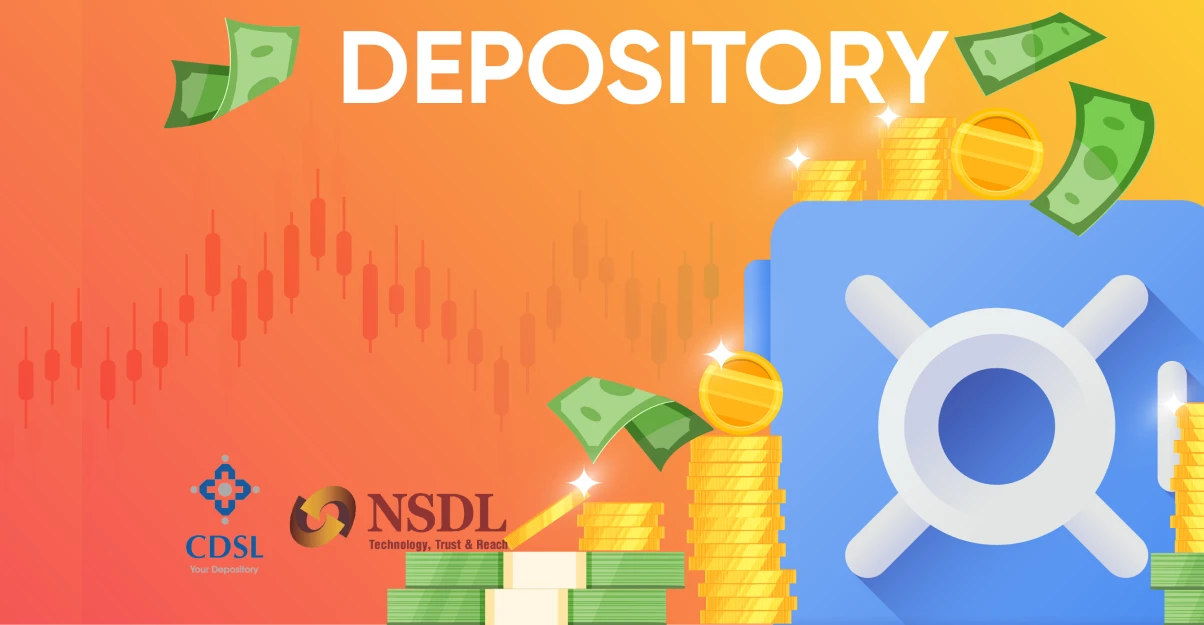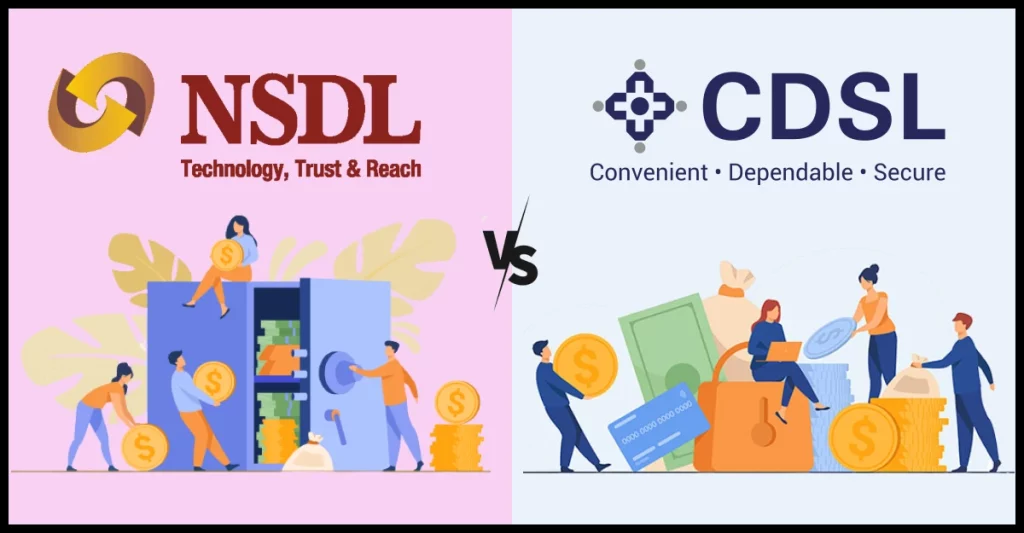Curious about the backbone of your investments? Meet NSDL and CDSL! The pillars of electronic securities trading in India. But the questions that arise in the battle of NSDL vs CDSL are- What are these? How do they differ?

Think of NSDL, born in ’96, and CDSL, the newcomer in ’99, as the custodians of your financial playground. Now, the plot thickens – they may seem like two peas in a pod, but have numerous differences.
Let’s untangle the web and explore the distinctive features of NSDL and CDSL, offering you a roadmap to navigate the intricate world of securities.
Ready to demystify?
Let’s delve into the pragmatic distinctions shaping your investment landscape!
(A) NSDL vs CDSL: Comparing the Profiles
The following table compares the profiles of both the entities-
| Aspects | NSDL (National Securities Depositories Limited) | CDSL (Central Depositories Services Limited) |
| Type of Company | Semi-Government | Public |
| Operating Segment | NSE (National Stock Exchange) | BSE (Bombay Stock Exchange) |
| Traded as | BSE:544021 | NSE: CDSL |
| ISIN | INE004A01022 | INE736A01011 |
| Industry | Central Securities Depository | Depository Services |
| Founded | 1996 | 1999 |
| Headquarters | Mumbai (Maharashtra, India) | Mumbai (Maharashtra, India) |
| Key People | Padmaja Chunduru (Managing Director & Chief Executive Officer) | Nehal Vora (Managing Director & Chief Executive Officer) |
| Products & Services | Demat account, Transfer and Settlement of Securities, Depository Service | Dematerialization of securities, Transfer and Settlement of securities |
What did you understand from the table? Both entities work in the same segment but for different stock exchanges! It may sound a bit vague for the uninitiated. Don’t worry!
We have broken down the concept in layman’s language so that everyone can understand what NSDL vs CDSL is all about.
Go through the next section and you will find out!
(B) Understanding the Concept: Depositories, NSDL, and CDSL
First of all, let’s break down the acronyms. NSDL refers to National Securities Depositories Limited and CDSL refers to Central Depository Services Limited.
Can you see any common term in the full forms?
Yes… Depositories!
First of all, you need to understand the concept of depositories and then dive into NSDL vs CDSL.
Let’s begin!
(B.1) Depositories in Stock Exchange

First of all, let’s break down the concept of depositories in a simple way.
Imagine you have a safe deposit box at a bank where you store important documents, jewelry, or valuable items. Now, think of depositories in the financial world like super-secure digital safes for your investments, such as stocks and bonds.
In the traditional days of the stock market, people used to have physical certificates for their stocks – like having paper versions of your precious items in that safe deposit box. But then came the era of depositories, making things way more convenient.
So, a depository is like a high-tech, digital safe for your financial assets. Instead of holding physical papers, it keeps an electronic record of your investments. This electronic record is stored in an account called a Demat (Dematerialized) account.
When you buy stocks, for example, instead of getting a paper certificate, the depository adds those stocks to your Demat account. And when you sell them, it removes them from your account – all done electronically.
Depositories play a crucial role in making the stock market more efficient. They ensure secure storage, easy transfer, and quick settlement of financial securities. They act as intermediaries between you (the investor), stock exchanges, and other players in the market, ensuring that buying and selling investments is smooth and secure.
In a nutshell, depositories make handling investments in the modern era much more straightforward and secure.
(B.2) Concept of NSDL & CDSL

Think of NSDL and CDSL as your trustworthy financial guardians, each having its own secure vault for your electronic investments. Let’s break it down in a simpler way.
Imagine you’re Investor A, and you choose NSDL. It’s like picking a high-tech safe with a special code starting with ‘IN’ to keep all your electronic stocks and bonds safe.
Now, meet Investor B, who goes for CDSL. This is like having another reliable safe, but with a different 16-digit code, guarding all their electronic treasures.
Investor A prefers trading on the National Stock Exchange (NSE), and NSDL, being an expert for NSE-related stuff, makes sure everything runs smoothly. On the other hand, Investor B is into assets on the Bombay Stock Exchange (BSE) and relies on CDSL for hassle-free trading.
When companies decide to share profits with investors (dividends), NSDL and CDSL make it simple – like magic! You get your dividends without any fuss, and it’s all electronic – no more dealing with paper certificates.
Now, imagine you’re Investor C, wanting a slice of both NSE and BSE action. Easy! Open accounts with brokers connected to both NSDL and CDSL – it’s like having two safes for your investments.
In this story, NSDL and CDSL make electronic trading easy and keep your investments safe. Whether you’re with NSDL for NSE or CDSL for BSE, it’s up to you. These financial guardians are here to make your money matters simple and secure.
(C) NSDL vs CDSL: A Brief Overview
Now, let’s have a brief overview of both the depositories.
(C.1) NSDL (National Securities Depository Limited)
Founded in August 1996, National Securities Depository Limited (NSDL) operates as an Indian central securities depository with its headquarters in Mumbai. Recognized as the pioneer electronic securities depository in India, NSDL boasts national coverage and was established following a recommendation by a key national institution dedicated to India’s economic development.
Its demat accounts currently manage assets valued at $4 trillion. NSDL extends its services to a broad spectrum of stakeholders, including investors, stock brokers, custodians, issuer companies, and business correspondents, leveraging its extensive network of Depository Participants (DPs) and digital platforms across the nation.
(C.2) CDSL (Central Depositories Services Limited)
Established in 1999, Central Depository Services (India) Ltd. (CDSL) operates as an Indian central securities depository and holds the distinction of being the largest in the country based on the number of opened demat accounts.
In a noteworthy achievement, CDSL set a milestone in February by becoming the first depository in India to surpass 60 million active demat accounts. As of March 2022, CDSL manages assets valued at ₹37.2 trillion, with an extensive network of over 580 depository participants affiliated with its operations.
(D) NSDL vs CDSL: What are the major differences?
Go through the following table to know the major differences of NSDL vs CDSL
| Distinctive Features | NSDL | CDSL |
| Full Form | National Securities Depository Limited | Central Depository Services Limited |
| Core Purpose | Serving as the pivotal Indian central securities repository for electronic securities trading | Functioning as a key central securities depository providing services to the Indian securities market |
| Inception Year | Established its foundation in 1996 | Formed in 1999 |
| Market Influence | Commands a larger market share concerning the number of DEMAT accounts | Holds a relatively smaller market share in terms of DEMAT accounts |
| Depository Participants (DPs) | Higher Count of DPs | A comparatively smaller number of DPs |
| Primary Market Operation | Primarily operates in association with the National Stock Exchange (NSE) | Principal market focus is on the Bombay Stock Exchange (BSE) |
| DEMAT Account Structure | Identified by a 14-character numeric code beginning with ‘IN’ | Characterized by a 16-digit numeric code |
(E) Functional Differences: NSDL vs CDSL
Now, let’s go through some functional differences between the two-
| Functional Differences | NSDL | CDSL |
| Establishment Backing | Promoted by institutions such as Industrial Development Bank of India (IDBI) and National Stock Exchange (NSE) | Backed by the Bombay Stock Exchange (BSE) and several leading banks in India |
| Investor Accounts | Boasts over 2.2 crores (22 million) investor accounts | Holds over 1.5 crores (15 million) investor accounts |
| Corporate Promotion | Prominently promoted by IDBI Bank, NSE, and other premier financial institutions | Major shareholder is the Bombay Stock Exchange (BSE), with support from leading banks like State Bank of India (SBI) |
| Operational Reach | Extensive network with 36,184 DP service centers across India | Offers services through 592 DPs and manages a broad network of participants |
| Key Services | Facilitates e-voting, electronic access to information, electronic pledges, and more | Provides Easi (Electronic Access to Securities Information), e-locker facility, pledge, and hypothecation services |
| Pioneering Status | The first electronic depository in India, transforming the capital market since 1996 | The second official depository was established in 1999, contributing to the evolution of the Indian securities market |
Note: Do you know about the most popular trading and investment bets in the power sector of the Indian economy? They’re none other than Tata Power vs Adani Power. Go through the article for detailed information.
(F) Final Words: Which is better in NSDL vs CDSL?
Are you confused about NSDL vs CDSL? Which one is better for you? Well, NSDL and CDSL as two options for you to keep your investment goodies safe.
NSDL has been around since 1996, like the wise old owl, securing a big piece of the depository pie. On the other side, there’s CDSL, the younger sibling born in 1999, steadily growing and reliable.
Think of this choice as picking the best safe for your money adventures. If you’re more into National Stock Exchange (NSE) vibes, NSDL’s your go-to pal. Prefer the Bombay Stock Exchange (BSE) scene? Well, CDSL is your reliable sidekick.
It’s like choosing your adventure – the seasoned giant NSDL or the steady riser CDSL. Take a peek at what each brings to the table, weigh your options, and dive into your money journey with the one that feels right for you.
Your money, your call!

